
Portuguese Guitar Collection, rare instruments
from: Ulisses
Gracio, Joao Palmeiro, Manuel Cardoso, Oscar Cardoso, German
Vazquez & Ronald Fernandez, Kim Gracio, Joao Pedro Gracio,
Santos Beirao, Fernando Meireles, Antonio Victor Vieira and Joao
Manuel Andrade. Revised: January 10, 2019.
This page shows several fine Portuguese Guitars (guitarras portuguesa de artesão) handmade over the last century. Some guitars were bought from the makers while some were found sitting in closets for many years. When necessary Ron Fernandez has restored these instruments to playing condition, refined the fret work and touched up the French Polished shellac finish.
Some of these guitarras are for sale. Make an
offer. Certain instruments must be picked-up in the United
States from Fernandez Music in Anacortes, Washington.
There are a number of very interesting Portuguese guitars on this page. The instruments with a scroll head are Lisbon style fado guitars (guitarras de fado). The instruments with a teardrop style head design are Coimbra guitars (guitarras de Coimbra). The Lisbon guitars (guitarras de Lisboa) usually have a string length of about 440mm while the Coimbra guitarras have a string length of about 470mm.
Photo Below: This splendid guitarra is a Lisbon fado guitar.
There is no label glued inside the guitar on the back but there is
one glued to the interior right side which states "Ulisses 1964".
This guitarra Made in Lisbon, Portugal. I showed photos of this
instrument to my friend in Lisbon who recognized it as a Ulisses
Gracio Guitar. It has a well proportioned scroll head, with an
unusual white twisted ornamental strip. The edge of the soundboard
is elaborately inlaid. $7000.

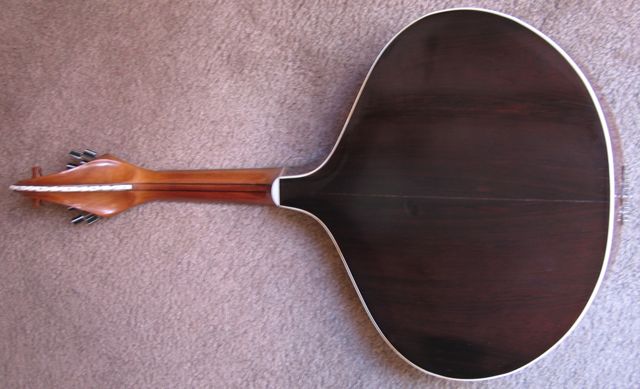
Above is a photo of the back of the "Ulisses" guitarra. Take notice of the shape of the body--it is quite wide, this was typical of Lisboa guitarras of the 1960s. It has a spruce soundboard, rosewood back and sides, ebony fingerboard. It has a very good sound and playability. Even though it was made in 1964 this instrument is in excellent condition--it seems to have been purchased but never played. I repaired a crack in the back, French Polish the body, refined the fret work and set-up the action. Ulisses was one of the famous Gracio family, other family members were Kim Gracio, Joao Pedro Gracio, Joao Pedro Gracio Junior. All of the instrument building Gracios are now deceased except for Gilberto Gracio, a 3rd generation luthier, who still makes professional guitarras.
Below are 2 photos of a João Palmeiro Lisboa style guitar made in
1994. It has a spruce soundboard, rosewood fingerboard, Portuguese
Walnut. French Polished Finish, set-up and fret refinement by Ron
Fernandez. This instrument was made for me by Senhor Palmeiro. I
carefully kept it in my personal collection and it is in very fine
condition. I had a few other guitarras from Palmeiro which in the
1990s I sold to my friend in Japan. Joao Palmeiro is now deceased.
In the 1990's I use to travel on the ferry boat from Lisboa across
the Tagus River to see him in the charming town of Montijo. He had
a most interesting workshop. It was large and airy on the 2nd
floor of an old building. It was filled with pieces of wood which
were drying and on the walls hung instrument-making forms for
constructing a variety of Portuguese folkloric instruments such as
violas, and cavaquinhos. I also remember that there was a bucket
where he was soaking cow bone in what he called laite (which means
"milk")--I think that was colloquial term for lime.; this soaking
process gave the bone (used for nut and bridges) a kind of glass
like sound when you struck piece together. Joao Palmeiro was a
very friendly man who was very devoted to his craft of making
folkloric portuguese instruments. He would spend time noting many
details to me. For example, he carefully explained to me about the
proportionals of the scroll head used on the Lisboa guitarra and
he also made me aware of the difference between the shape of
finger rests on the Coimbra and Lisboa guitarras. His wife use to
help with making the instrument cases--I think he did the wood
work and she did the inside fabric work. Price: $6000.00
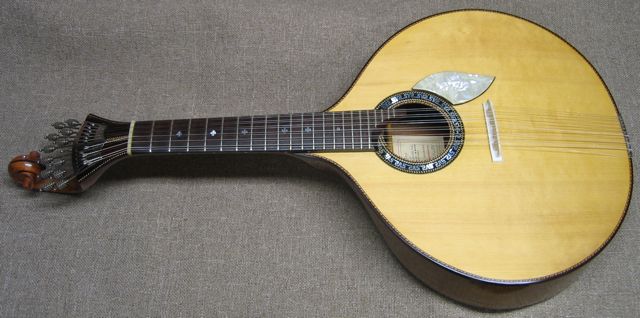
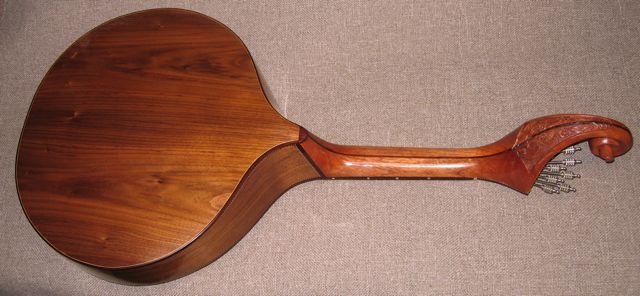
Below: João Palmeiro Coimbra style Guitarra. Made in Montijo, across from Lisboa. 1994. This guitarra was made for me by Joao Palmeiro
I did the final French Polished finish, refined the frets and
set-up the instrument. The face is spruce, the fingerboard is
rosewood, the back is probably sycamore. 470mm scale. Price: SOLD
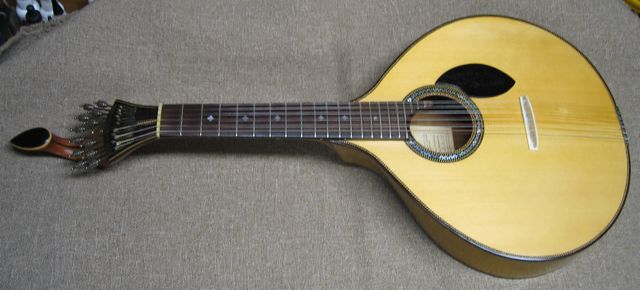
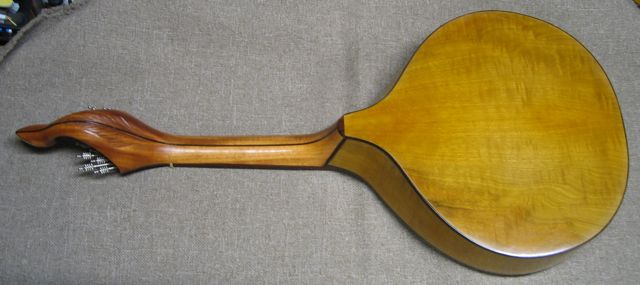
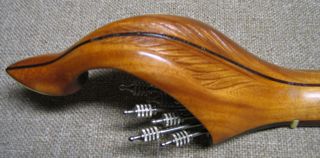
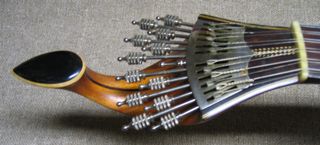
Above: Joao Palmeiro, 1994 Coimbra head (back and front) and above the head photos is a photo of the beautiful back of this guitarra. The entire instrument was French Polished by Ron Fernandez.
Below: Kim Graçio (1912-1994) Lisbon Style Portuguese
Guitarra.The guitarra label shows his shop at: Rua 3, Bairro Santa
Engrácia 37 r/c. Dt.º, Lisboa. Kim Gracio was one of the most
highly acclaimed makers of Portuguese guitars, he was a member of
the Graçio instrument making family. He is also known as Joachim
Gracio. I have been told by Luis Penedo who knew Kim Gracio that
Kim had immigrated to the Chicago area for a number of years where
he worked doing violin repairs. Before I acquired this instrument,
the soundboard had been repair. Sometime later I had Kerry Char,
master luthier in Portland, refine the repair. This is a good
sounding professional instrument. The nut width is 38mm, the scale
length is 440mm. French Polished. The neck base (inside the
guitarra) has the number 52/55 and the name Kim Gracio ink stamped
on the raw wood. Price: is $6500 to be inspected in Anacortes,
Washington
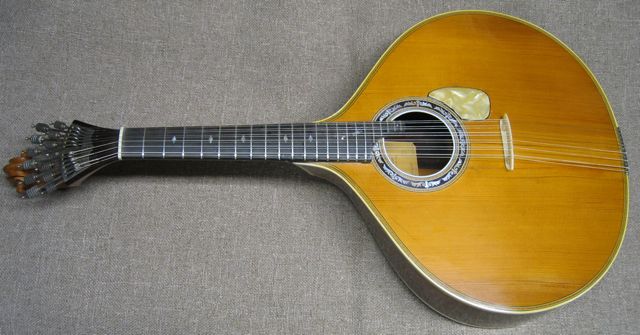

Below: German Vazquez and Ronald Louis Fernandez, Coimbra
Guitarra. This instrument was one of 3 constructed by German
Vazquez, in California; the fretting, bridge and French polishing
were done by (your truly) Ronald Fernandez. German Vazquez (a
world class maker born in Paracho, Mexico) constructed this
instrument after he had examined several instruments in this
collection. The dimension of this guitarra are come close to those
of my Fernando Meireles Coimbra Guitarra, which in turn has design
proportions similar to guitarras made in the 1970s by Gilberto
Gracio's. Price: $5000
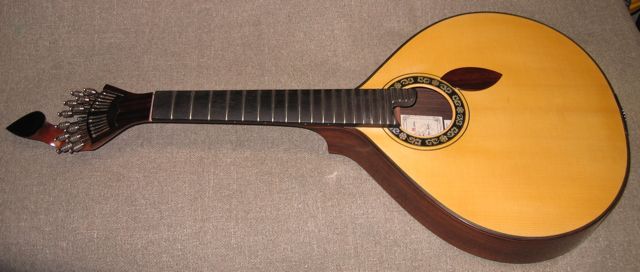
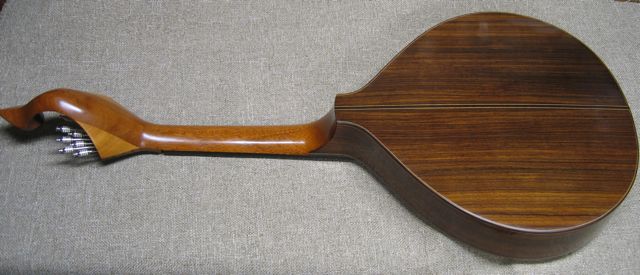
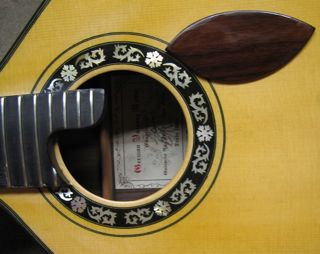
Below: Joao Pedro Gracio Junior (1903-1967) Lisboa Fado Guitarra
made 1962. Spruce soundboard, Portuguese Walnut body, ebony
fingerboard. This is a guitarra had been sitting in a closet for
yeasr in the San Francisco Bay Area. It is a simple instrument, no
mother of pearl or fancy inlays. It is a straight forward, well
made, traditional sounding instrument. It is in quite good
condition. When I received it in the 1990s I had to do some minor
fert leveling but otherwise it is original. SOLD
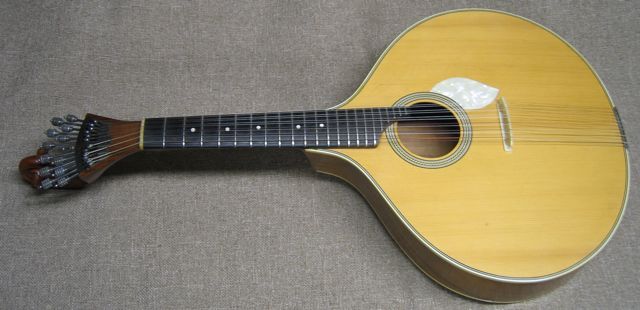
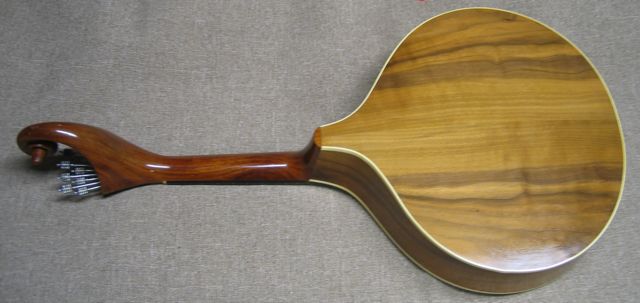
Below: Santos Beirao, Lisboa 1950 to 1970's. Solid spruce face,
rosewood fingerboard, and (probably) a mongoy back. Fret work,
set-up and French Polished by Ron Fernandez. This was a good
production instrument sold in Lisbon in the mid-20th century. This
one was sold through the Santos Beirao shop in the Chiado, which
burned down in the late 1980s. . I found it in Palm Springs,
California. It had a crack in the back--which was repaired by
German Vazquez and is now just about invisible. In addition to
this Santos Beirao I have another one which had a crack in the
face which has been repaired soundly but which is still visible.
Apparently, there were thousands of guitarras sold by Santos
Beirao--I have seen many and have been sent photos of many more.
They are nice instruments. Their shape is very pleasing. The
neck-body joint is very strong. The wood seems to have been dried
properly. The neck shape feels good. They have a good tradiitonal
sound. If you find one in good shape expect that you will need
fret, nut and bridge work. SOLD
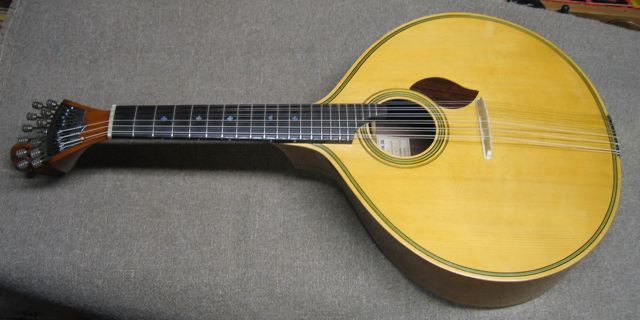
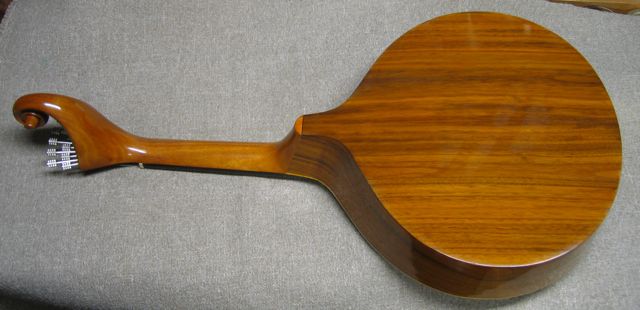
Above: The light color on the back of this guitarra is merely a light reflection
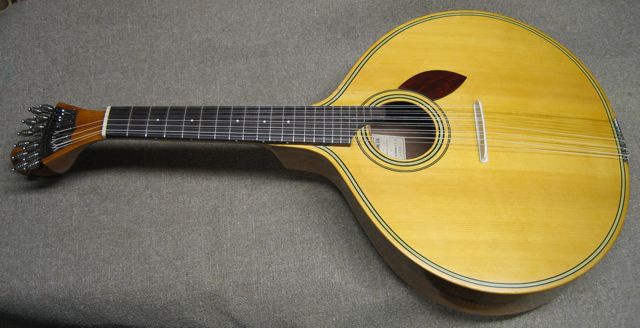
Above: Here is the other Santos Beirao fado guitarra, it was made
in Lisbon, mid-20th century. Repaired crack in face. French
Polished and set-up by Ron Fernandez. SOLD
Below: Antonio Victor Vieira, Guitarra Lisbon, probably 1920s. Repaired and French Poished by Ron Fernandez. I have seen a number of guitarras from this maker. They are nice sounding but a bit thin. These early Antonio Victor Vieira guitarras sound more like a loosely strung mandolin as opposed to a powerful, modern Portuguese guitars. These Portuguese guitars from the early 1920s were more lightly constructed than later guitarras and they seemed to use lower tension strings.
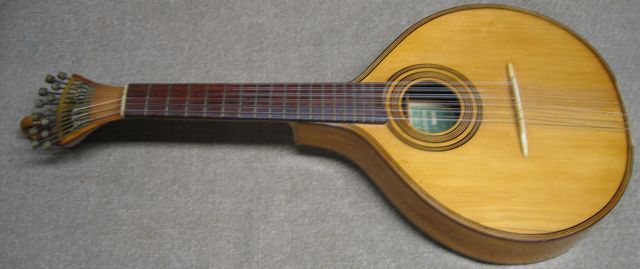
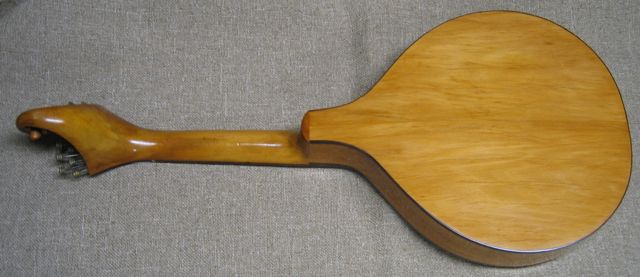
Above: Back of Antonio Victor Viera. There are several repaired
cracks in the back of this instrument. It has a very interesting
sound because the scale is shorter and the strings are looser than
modern guitarras. I will consider offers over $1600.00.
Below: Fernando Meireles, Coimbra Guitarra made in 2002, 470mm scale. Fernando has his shop in the Student Union of Coimbra University Fernando Meireles's label says Jose Fernando Meireles but he goes by Fernando. He makes great instruments. Many of the world class modern players can been seen playing his guitarras on CD covers or on YouTube. The ornamentation of the Meireles Coimbra guitar is very simple--the rosette is marquetry not mother of pearl. The proportions of the instrument are very elegant. For me the neck dimensios are perfect. When I sit and play this guitarra I get lost in time and it inspires me to improvise. I should say that Fernando Meireles is a fine performer of a number of instruments including the hurdy gurdy--you can probably see him on YouTube. Pedro Caldeira Cabral often played these guitarras. This guitarra is not for sale.
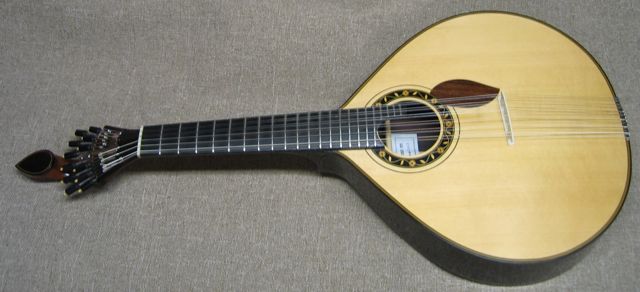
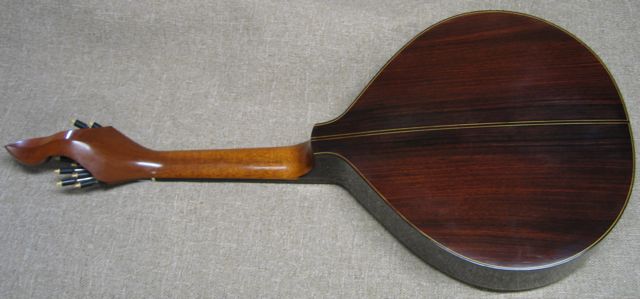
Below: Joao Manuel Andrade Portuguese guitar, made in Lisbon around 1895. Many of these mandolin size guitarras were imported into England. Notice how the shape of the body is different than the other instrument on this page--the body is much narrower. The sound of this instrument is more liked a mandolin than like the modern Portuguese guitar. $1800.

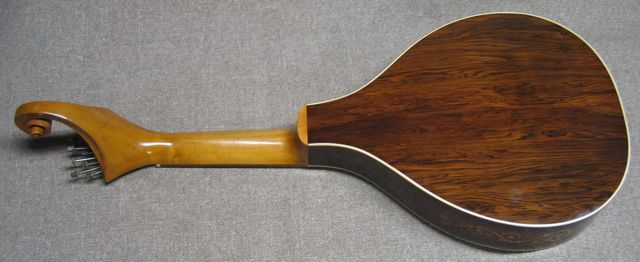
Above: Joao Manuel Andrade, Lisboa, ca. 1895. Make offer.
Below: Manuel Cardoso Lisboa Guitarra ca. 1980. I personally bought this guitarra from Oscar Cardoso, the son of Manuel Cardoso). It had been refurbished by Oscar after he had received it back from an elderly mad who could no longer play it. I very much enjoy playing this instrument. It has the spirit of many nights of fado music. Not for sale.

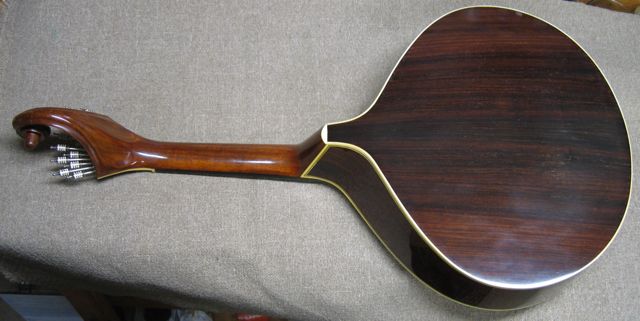
Above: Manuel Cardoso, Lisboa, ca. 1980, Private Collection.
Below: Oscar Cardoso Lisbon style guitarra with a 470mm scale. Made in Lisbon, 2001. Oscar Cardos made this instrument for me. It has a rich sound, almost like a harischord. Oscar learned instrument making from his father, Manuel Cardoso, but also went to Cremona, Italy to study and refine his instrument making skills. Oscar is a very innovative builder. In recent years he has been making guitarra which have a 6 to 8 inch opening in the back. When I heard about this I was confused, I did not understand the logic of making a big hole in the back of a guitarra. I always though that the sound must bounce off the back. Apparently, having a guitarra with a big hole in the back is easier to record--the sound levels of all the frequencies are more balanced. When I met Luis Guerreiro, who performed with Mariza for some years, he was performing with an Oscar Cardoso with a open hole in the back. This guitarra is not for sale.
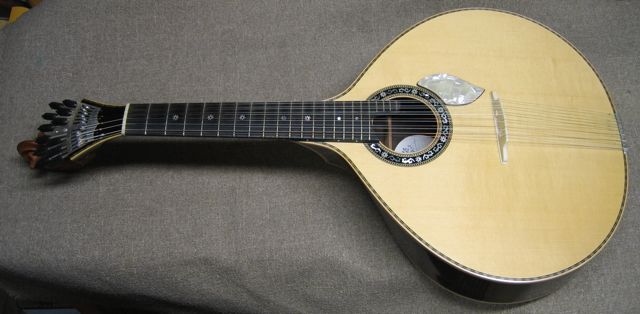
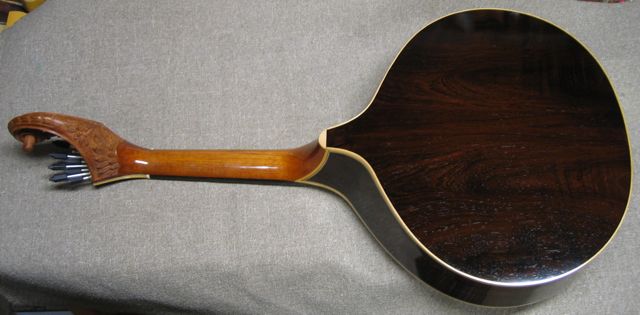
Above: Oscar Cardoso Guitarra, made inLisboa 2001. Private Collection, not for sale.
Below: Unnamed Guitarra, unknown origin. Found in Southern California. Judging from the tuners it is from 1920 to 1950. I don't know if it was made in Continental Portugal, the Azores or in the United States. It has a"pine" soundboard, rosewood fingerboard, body may be of beech (but I am not sure), 472mm scale. This guitarra needed repair work. The back panels had shrunk so there is a separation between the two panel. There is a split in the back right panel. I have SOLD this guitarra to someone who is repairing it.

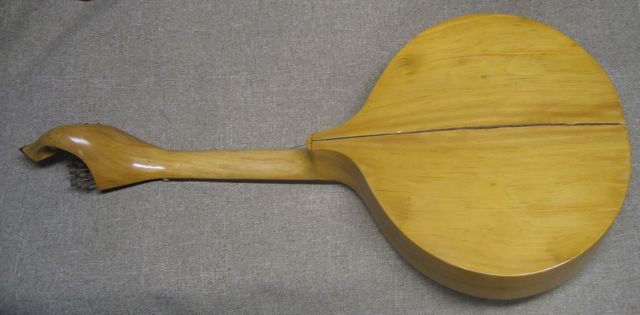
Go to Portuguese Guitarras For Sale.
If you have any questions, email me: ron@fernandezmusic.com
Return Fernandez Music Home Page
Ron Fernandez, Fernandez Music, P.O. Box 2130, Anacortes,
Washington 98221, Phone 949-856-1537